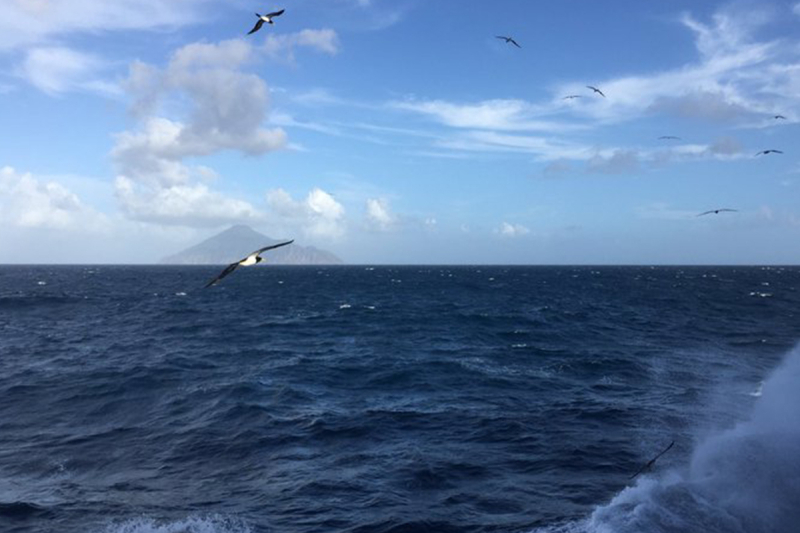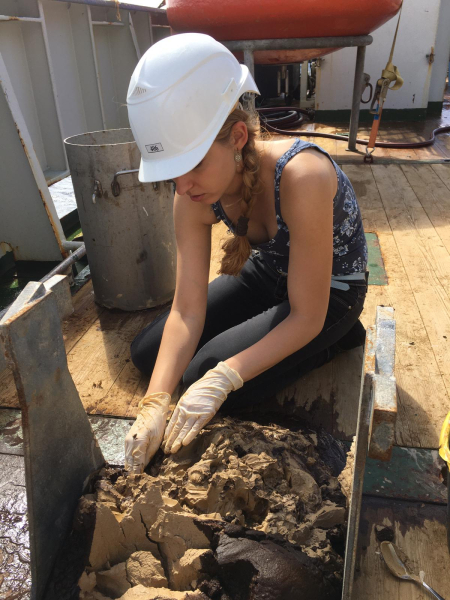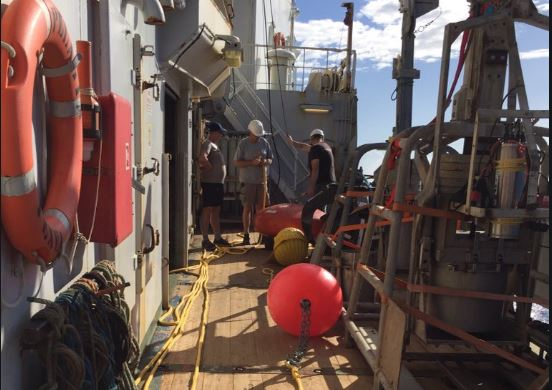18 december
The team arrived back in Guadaloupe after a fantastic week and a half of exploring the Sababank. They made some amazing discoveries in the world's largest and deepest sinkholes. Yesterday the final sampling was completed, and last night RV Pelagia steamed back from Saba to Guadaloupe. A lot of research work to be done back home!


17 december
As mentioned in the blog of 12 december, one of the sinkholes seems to seep gas. The bubbles don't reach the surface of the water, and we don't know yet what kind of gas it is. We managed to get some sediment samples and they look 'unfamiliar', so we are eager to find out what secret is hiding at the bottom... Tomorrow will be our last day on board before arriving at Guadaloupe, the end of the expedition with a lot of work to take home.
By Fleur van Duyl

16 december
Door Erik Meesters (WMR)
Het beloofde een spannende expeditie te worden en dat heb ik geweten. De eerste dag dat we met onze camera’s de zinkgaten ingingen gebeurde het drama. Het laatste zinkgat van de dag, het kleinste en steilste van alle zinkgaten was bijna fataal. Het frame met camera’s bleef achter een richel hangen. Op zo’n moment breekt de paniek wel een beetje uit. De boot zit vast en trekt met al zijn gewicht aan de kabel. Dan weet je, dit gaat kapot! Moeten we de lijn kappen, zijn we alles kwijt. Komt ie nog omhoog, dan is er van alles aan gort. Richels in de rotsen boven je kun je niet goed zien en als het frame daarachter vast komt te zitten mag je gaan bidden dat het goed komt. Het cameraframe is zwaar staal en super stevig en kan wel tegen een stootje, maar de apparatuur die erin is bevestigd is minder sterk en er kan altijd een rotsblok door een van de openingen in het frame komen. Het frame heeft ook 2 sonars aan boord waarmee we zowel voor als onder ons de omgeving scannen om te zien of er een obstakel op ons afkomt. Dat zien we aan boord, meestal, maar soms kun je toch nog iets missen (zie foto's van 9 december hieronder).

Nu dus ook. Vanaf de brug wordt gevraagd waarheen de boot moet. Het is nu teamwerk tussen degene achter het roer en de lier. De lijn moet meteen gevierd worden om de krachten ervan af te halen en de boot moet in de achteruit of zijwaarts wegdraaien van de muur, maar voordat zo’n schip van 70m gedraaid is, ben je wel een minuut verder. Gelukkig komt het frame los en kunnen we het weer omhoog trekken maar er is veel beschadigd en de volgende 2 dagen is onze elektrotechnicus er fulltime mee bezig, inclusief een groot deel van de nachten. Gelukkig is het allemaal goed gekomen en hebben we nog veel van het programma kunnen doen. De zinkgaten hebben we verder verkend en onderzocht en we hebben spannende nieuwe ontdekkingen gedaan die het gebied nog meer bijzonder maken dan het al is. Zo vonden we piepkleine koraaltjes tussen de kalkalgentorentjes. De torentjes zitten vol met gaten die weer vol zitten met andere organismen zoals sponzen en dus ook koraaltjes.

De bovenkant van de bank is bijna geheel bedekt met kalkalgen en koralen, een uniek gezicht. De kalkalgen zijn op dieptes tussen de 80 en 120m de meest efficiënte groeiers en zij vormen de habitat, de omgeving, waar de andere organismen in leven.
Met een geleende grijper van offshore bedrijf Bluestream hebben we monsters uit de zinkgaten kunnen nemen. We zijn allemaal zeer opgewonden over alle nieuwe ontdekkingen en kunnen niet wachten met het analyseren van onze monsters en beelden. Nog maar enkele dagen en dan gaan we weer terug.
14 december




12 december

12 December, another day past. What day is it? You lose track of the different weekdays on board. The food is great and most of us prefer Heineken 0.0 above Amstel 0.0 alcohol when we meet for the program after evening meals.
Yesterday the moorings were deployed in two different sinkholes. Little lights flicker in the night to show where they are. For the day-night sampling, particularly during night it is crucial to see the buoys. Sinkholes with moorings are quite narrow for the Pelagia to navigate in and out, so the light is crucial.
Today the Saba Bank revealed another surprise. Via the Saba Bank marine park we got coordinates of a purported hotspring (found by fishermen) in one of the sinkholes we planned to explore. At ca 280m depth a plume was detected with the multibeam, maybe a methane seep? The CTD profiles showed an amazing steep gradient in among others oxygen in the sinkhole.
There is apparently stagnant water in some sinkholes, while most of them (explored till now) appeared to be quite well mixed and oxygenated down to the bottom. The boxcore refused to close in this peculiar sediment in this gas seep sinkhole. Hope to have a look at these sediments with the HD video frame in the coming days (repair is ongoing after contact of the frame with a steep wall).
Tired, my last activity today is to check if someone wants to drink a 0.0 Proseco?? before hitting the sack. Spirits remain high! By Fleur van Duyl

11 december
Yesterday during the last cast with the polyp grabber close to sun set we managed to collect 2 pieces of the calcium pillars around 100m depth in one of the sinkholes. Great excitement when they came onboard. They are really amazing, highly porous, bright red and purple structures, extremely hard, heavy and strong. It took all the force of the grabber to break them off at last. The structures mainly consist of calcium carbonate and are covered as well as mainly built by various species of crustose coralline algae. This was a great catch. Hope for more in the course of the week.
By Fleur van Duyl

10 december
Another exciting day at the Sababank. See pictures below.

9 december
Another sensational but also extremely stressfull day passed. Beautiful images of the deep carbonate platform (ca 85 m deep) with high cover of coralline algae, Halimeda, sponges and corals. We explored several sinkholes today by lowering the camera system carefully in the sinkholes. In two of them we found again the exciting CCA pillars between 90 and 110m depth. We found extensive fields of CCA pillars in cristal clear waters on the bottom of these sinkholes.

In a neighboring sinkhole of comparable depth, conditions were quite different. Murky conditions, sandy bottom and what appeared a dead army of CCA pillars at one side. The last sinkhole we went into today was almost fatal for the camera system. It hooked onto a steep sinkhole wall. It took a while until we freed it, but damage was done. It will need days to repair cable and connectors. But we have good equipment news as well, the CTD rosette will be operational tomorrow again and we will collect water from the sinkholes for all sorts of chemical and biological analyses. We are eager to find out what more secrets and surprises sinkholes have for us.
By Fleur van Duyl
8 december
At 8:00 am. we were at St Eustatius where Johan, Masru and Kimani from CNSI (Carribean Netherlands Science Institute) were already on the quay. John skillfully set the Pelagia along side and Masru and Kimani were quickly on board. Anchors away and we arrived at the first station at around 9:15 p.m. As we have many CTDs in surface water, the men on deck have put the old Niskin rosette back on. Apparently this works faster. Station 1 and 2 ran smoothly. Masru and Kimani are instructed by Matthew and Karel how to take samples from the Niskin bottles for DIC nutrients. Unfortunately we had contact failure with the CTD on station 3. Sven makes every effort to find out where the problem is. If it takes longer we will have to do the rest of the transect (9 stations today) with the Aquaflow. Hopefully the problem will be solved soon. The plan is to drop Masru and Kimani from the CNSI back at the port around 5 pm.

7 december
Everyone is busy unpacking and making arrangements in the different laboratories. At 5:00 pm we leave the harbor and head for St.Eustatius whilst enjoying a beautiful sunset.
By Fleur van Duyl
6 december
The next day our flight was on time, and we were able to reach the airport on time with a tram despite the strike. All in all, we arrived more than a day late on the Pelagia, where we boarded around 10 pm. local time (agent had forgotten us ...). Fortunately, our cook Hasan had meal ready for us so late in the evening.
By Fleur van Duyl
5 december
Pfft, all in all an exciting start to this Sinkhole expedition. On the way there we stranded in Paris because of fog and / or the transport strike in France and Paris. The bus from CDG to Orly luckily still went, but we missed our flight to Guadeloupe. Spend the night in a hotel near the airport.
By Fleur van Duyl

